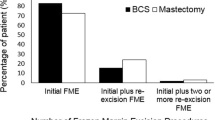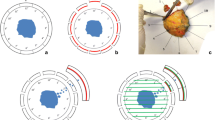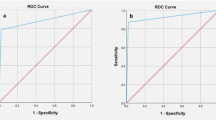Abstract
Background
Whereas specimen radiography (SR) is an established strategy for intraoperative resection margin analysis during breast-conserving surgery for nonpalpable lesions, the use of frozen section analysis (FSA) is still a matter of debate.
Methods
A retrospective review was conducted of 115 consecutive operations in which the two objectives sought were the excision of nonpalpable malignant lesions and breast conservation. Breast surgery was performed in the Gynecology and the Surgery Departments at the Basel University Hospital Breast Center. Whereas one department preferably uses SR for intraoperative margin assessments of lesions involving ductal carcinoma in situ (DCIS) or atypical ductal hyperplasia, the other uses FSA to increase the rate of complete removal of these lesions with a single procedure. The respective accuracy and therapeutic impact of these two techniques are compared here.
Results
Intraoperative resection margin assessments were performed with FSA in 80 and SR in 35 of a total of 115 operations performed on 111 patients with pTis, pT1, or pT2 nonpalpable breast cancer. FSA diagnostic accuracy, sensitivity, and specificity were 83.8%, 80.0%, and 87.5%, respectively, compared to 60%, 60%, and 60%, respectively, for SR. FSA tended to have a stronger therapeutic impact than SR in terms of the number of patients in whom initially positive margins were rendered margin-negative thanks to intraoperative analysis and immediate reexcision or mastectomy (27.5% vs. 14.3%; p = 0.124). More importantly, significantly fewer secondary reexcisions were performed in the FSA series than in the SR series (12.5% vs. 37.1%; p = 0.002). Finally, the intraoperative detection of invasive cancer with FSA led to a significantly lower number of secondary procedures for axillary lymph node staging (5% vs. 25.7%; p = 0.001).
Conclusions
The present results suggest that FSA may be more accurate than SR for analyzing intraoperative resection margins during breast-conserving surgery for nonpalpable lesions.
Similar content being viewed by others
References
Arriagada R, Le MG, Rochard F et al (1996) Conservative treatment versus mastectomy in early breast cancer: patterns of failure with 15 years of follow-up data; Institut Gustave-Roussy Breast Cancer Group. J Clin Oncol 14:1558–1564
Fisher B, Redmond C, Poisson R et al (1989) Eight-year results of a randomized clinical trial comparing total mastectomy and lumpectomy with or without irradiation in the treatment of breast cancer. N Engl J Med 320:822–828
Fisher B, Anderson S, Bryant J et al (2002) Twenty-year follow-up of a randomized trial comparing total mastectomy, lumpectomy, and lumpectomy plus irradiation for the treatment of invasive breast cancer. N Engl J Med 347:1233–1241
Jacobson JA, Danforth DN, Cowan KH et al (1995) Ten-year results of a comparison of conservation with mastectomy in the treatment of stage I and II breast cancer. N Engl J Med 332:907–911
Veronesi U, Banfi A, Salvadori B et al (1990) Breast conservation is the treatment of choice in small breast cancer: long-term results of a randomized trial. Eur J Cancer 26:668–670
Ernster VL, Barclay J, Kerlikowske K et al (1996) Incidence of and treatment for ductal carcinoma in situ of the breast. JAMA 275:913–918
Ernster VL, Ballard-Barbash R, Barlow WE et al (2002) Detection of ductal carcinoma in situ in women undergoing screening mammography. J Natl Cancer Inst 94:1546–1554
Weber WP, Zanetti R, Langer I et al (2005) Mammotome: less invasive than ABBI with similar accuracy for early breast cancer detection. World J Surg 29:495–499
Letton AH, Mason EM (1980) The treatment of nonpalpable carcinoma of the breast. Cancer 46:980–982
Rosen PP (1991) Pathological assessment of nonpalpable breast lesions. Semin Surg Oncol 7:257–260
Snyder RE (1980) Specimen radiography and preoperative localization of nonpalpable breast cancer. Cancer 46:950–956
Graham RA, Homer MJ, Sigler CJ et al (1994) The efficacy of specimen radiography in evaluating the surgical margins of impalpable breast carcinoma. AJR Am J Roentgenol 162:33–36
Mazouni C, Rouzier R, Balleyguier C et al (2006) Specimen radiography as predictor of resection margin status in non-palpable breast lesions. Clin Radiol 61:789–796
Sakorafas GH, Farley DR (2003) Optimal management of ductal carcinoma in situ of the breast. Surg Oncol 12:221–240
Klimberg VS, Harms S, Korourian S (1999) Assessing margin status. Surg Oncol 8:77–84
Cabioglu N, Hunt KK, Sahin AA et al (2007) Role for intraoperative margin assessment in patients undergoing breast-conserving surgery. Ann Surg Oncol 14:1458–1471
Camp ER, McAuliffe PF, Gilroy JS et al (2005) Minimizing local recurrence after breast conserving therapy using intraoperative shaved margins to determine pathologic tumor clearance. J Am Coll Surg 201:855–861
Cendan JC, Coco D, Copeland EMIII (2005) Accuracy of intraoperative frozen-section analysis of breast cancer lumpectomy-bed margins. J Am Coll Surg 201:194–198
Weber S, Storm FK, Stitt J et al (1997) The role of frozen section analysis of margins during breast conservation surgery. Cancer J Sci Am 3:273–277
Greene FL, Page DL, Fleming ID (2002) AJCC Cancer staging manual, 6th edn. Springer, New York, p 223
Walter SD (1998) Sensitivity. In: Armitage P, Colton T (eds) Encyclopedia of biostatistics. Toronto, Wiley, pp 4053–4054
Author information
Authors and Affiliations
Corresponding author
Additional information
Walter P. Weber and Stephan Engelberger have contributed equally to this work.
Rights and permissions
About this article
Cite this article
Weber, W.P., Engelberger, S., Viehl, C.T. et al. Accuracy of Frozen Section Analysis Versus Specimen Radiography During Breast-Conserving Surgery for Nonpalpable Lesions. World J Surg 32, 2599–2606 (2008). https://doi.org/10.1007/s00268-008-9757-8
Published:
Issue Date:
DOI: https://doi.org/10.1007/s00268-008-9757-8




